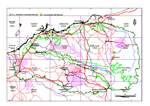Botanical name
Acacia aphanoclada x pyrifolia var. pyrifolia
Description
Wispy, spindly, single-stemmed, erect, glabrous shrubs 2-8 m tall, stems about 3 cm diameter at breast height, crown foliage sparse and concentrated at ends of the slender branchlets. Bark smooth, grey except upper branches pruinose. Branchlets pruinose. Stipules more or less spiny, absent from some nodes, small (1-3 mm long). Phyllodes narrowly elliptic to oblanceolate, mostly 5-11 cm long and 10-20 mm wide, slightly undulate, grey-green and pruinose; midrib prominent, lateral nerves openly anastomosing; apex narrowed into a slender, sharp point. Inflorescences axillary racemes or open, terminal panicles, the raceme axes 3-15 cm long and pale-coloured; peduncles 8-12 mm long, paired or solitary at nodes along the raceme axis, pale-coloured; heads globular, golden, densely 50-70-flowered. Flowers 5-merous; sepals free, linear. Pods not seen.
Characteristic features
Wispy, tall, single-stemmed, glabrous shrubs with inconsequential crown of sparse foliage and very slender, pruinose branchlets. Stipules small (1-3 mm long) and spiny although absent from some nodes. Phyllodes elliptic to oblanceolate, mostly 5-11 cm long and 10-20 mm wide, narrowed at apex into a slender, sharp point, glaucous. Flower heads arranged in elongated racemes (3-15 cm long) or open, terminal panicles.
Distribution and ecology
Known only from the Pilbara region of northwest Western Australia where it occurs as a few, small, scattered populations in the vicinity of Nullagine. It grows low in the landscape, often along dry watercourses on low rocky hills, on agglomerative material in grey-red soil with stony surface. The vegetation comprises Open Scrub with a ground cover of spinifex (Triodia longiceps and Triodia sp.).
Flowering and fruiting period
Flowering from late July to the end of September. It is not known if this hybrid sets fruit.
Taxonomy
Judging from morphological criteria it appears that this entity appears to be a hybrid between A. aphanoclada and A. pyrifolia var. pyrifolia. At one locality examined the putative hybrid grew with both parents, but at another locality A. pyrifolia was seemingly absent. In both these populations A. inaequilatera occurred with the putative hybrid, however, there is no morphological evidence to suggest that this close relative of A. pyrifolia is implicated in the hybridity. In the Pilbara A. pyrifolia var. pyrifolia occasionally develops a spindly, open growth form not dissimilar to that which is found in the putative hybrid. However, the spindly form of var. pyrifolia can be distinguished by its phyllode length: width ratio which does not exceed 2 (in A. aphanoclada x pyrifolia var. pyrifolia the phyllodes are more elongate with l: w = 4-7).
Notes
This plant would seem to have some horticultural potential on account of its unusual growth form and white branches. However, whether it could be effectively propagated may depend upon whether or not it produces viable seed.
Conservation status
There is insufficient information at present concerning this entity to justify including it on the Department of Environment and Conservation's Declared Rare and Priority Flora List.



